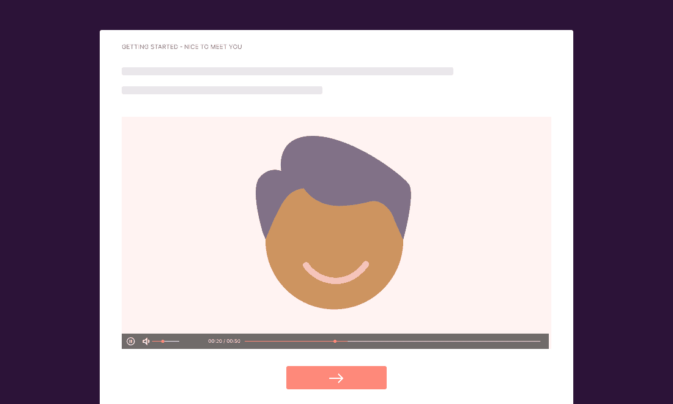Hiring with your heart or gut feeling is just not viable in today’s super-competitive talent market. One way to improve the accuracy of your hiring hit rate is by designing and using a candidate scorecard for interviews, so your team can support their hiring decisions with real, quantitative data.
With practical tools, like interview scorecards, your team has the insight for smarter decisions that save you time and effort. So let’s find out exactly how this tool can help you.
TL;DR — key takeaways
- An interview scorecard is a rating system for objectively assessing candidates’ skills. The scorecard system increases the fairness of interviews and provides data-driven insight that supports better hiring decisions.
- But there are even more benefits — reducing personal bias, spotting top talent faster, and ultimately streamlining the hiring process.
- We also unpack the best way to create and use interview scorecards to help the hiring team stay focused and gain the most from an initial interview with a candidate.
- Combining practical HR tools, like an interview scorecard template, with other resources like job task analyses and skills assessments will help your team save valuable time and effort.
- If you’re looking for simple, drag-and-drop style skills assessments to add to your toolkit, then Toggl Hire’s got just what you need for fast, enjoyable candidate screening, assessing, and hiring.
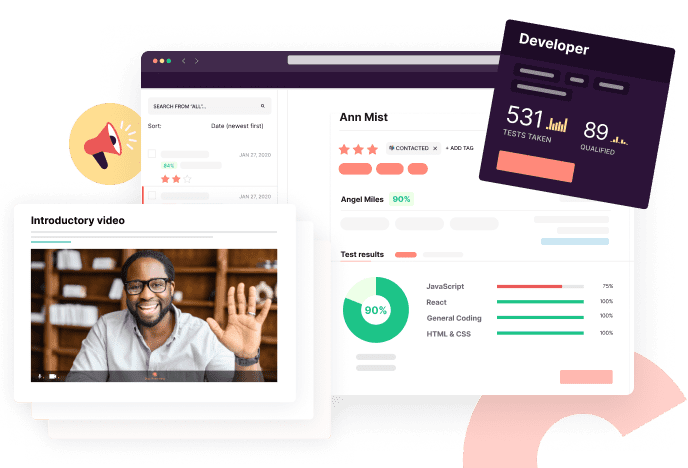
What is a candidate scorecard for interviews?
A candidate scorecard is a rating system interviewers use to score a candidate on how well they match a particular set of criteria for a role. Each person conducting the interview completes the same hiring scorecard by rating the candidate’s hard and soft skills listed as categories on the card.
With the entire panel rating each candidate on the same points, and collaborating after each interview on their findings, it supports a more objective and fair hiring process.
People are biased, emotional, and inconsistent when interviewing and, as a result, decades of industrial psychology research has found, the validity or predictive power of a typical unstructured job interview is around 20%, meaning that only one in five interviews increases the baseline odds that a hired candidate will be successful.
Ben Dattner | HBR
What’s more, these score sheets (as they’re also called) are often used in structured interviews, along with other tools, such as using a set of fixed interview questions. Why? Because they also produce quantitative data on candidates, which is the basis of structured interviewing.
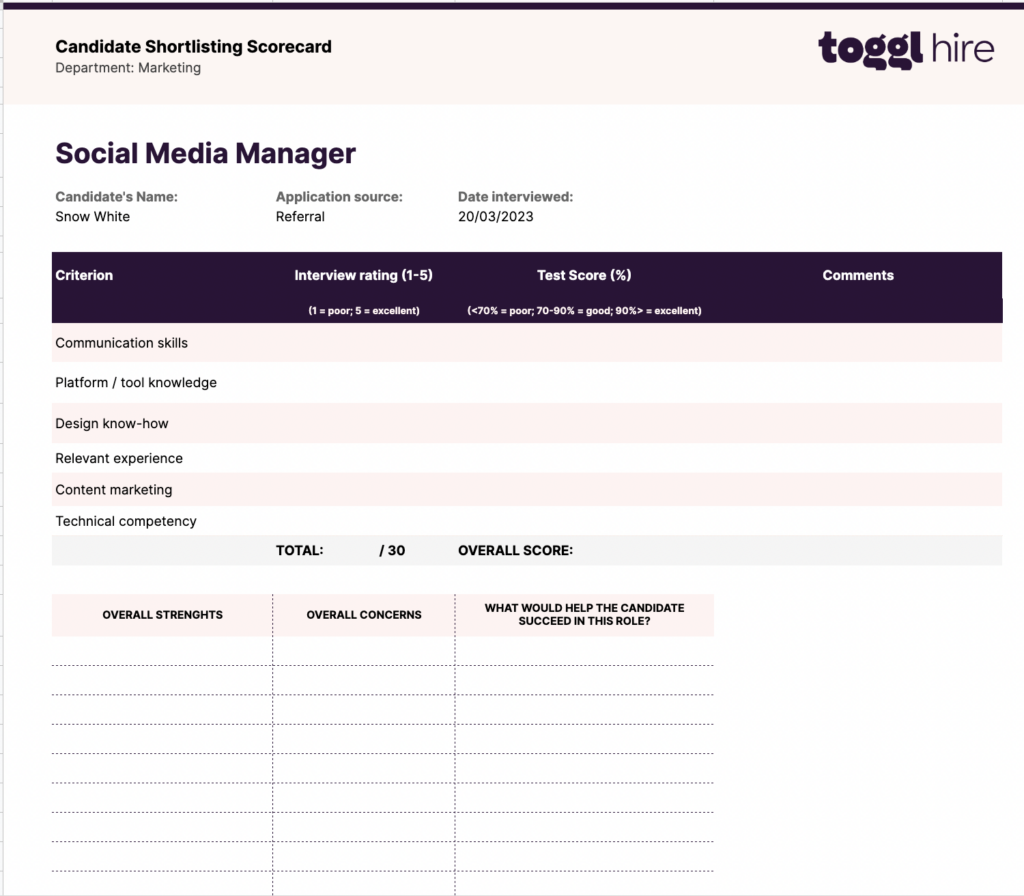
🔥 Don’t want to build your candidate scorecard from scratch? Download our FREE scorecard template for interviews and check out assessment template library for technical screening.
When to use a candidate scorecard in interviews
Interview scorecards can be very helpful if you’re dealing with broad, competitive roles.
For instance, a major accounting firm with a large graduate program will have thousands of applicants to screen and assess. Using a scorecard can help the selection team filter out the best candidates faster.
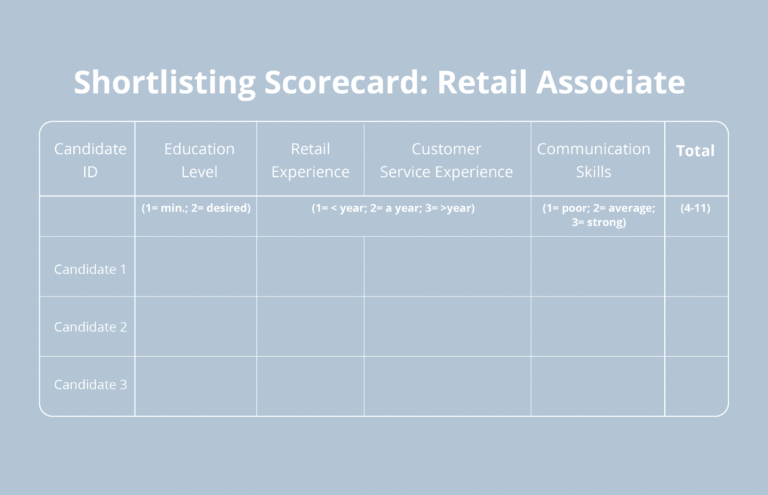
Another instance where interview scorecards are helpful is as a pre-screening tool for a large pool of potential talent — think of the massive flood of tech talent out there from the recent mass layoffs.
Interview scorecards can help with evaluating candidates that look like a good match for your company, employing a quantitative approach to selection that reduces unfair hiring practices.
Since “75% of employers reported making a bad hire in the last year”, tools like scorecards are essential for reducing bias.
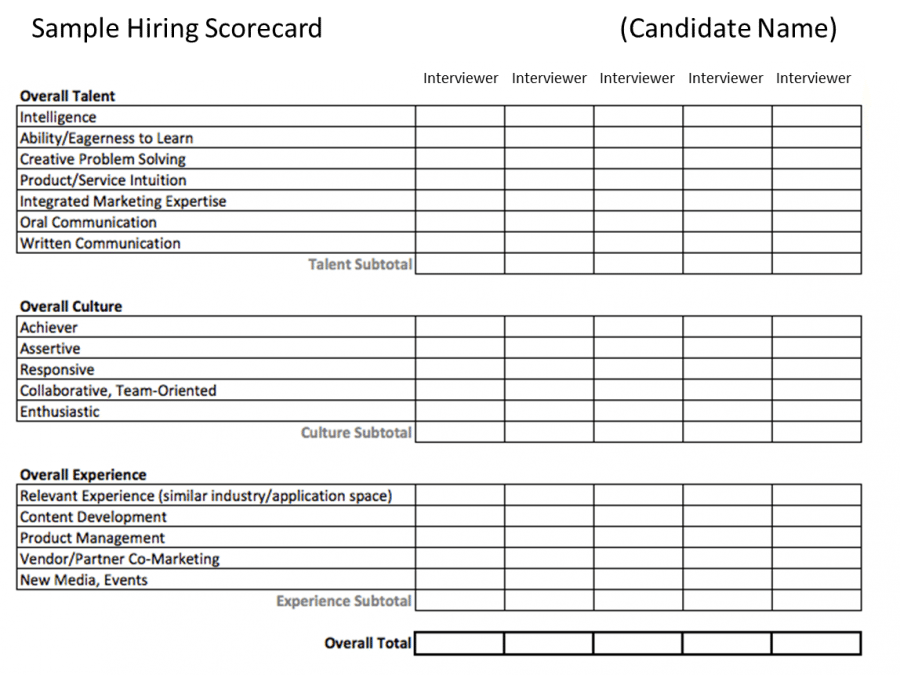
Not sure about the difference between unstructured and structured interviews? 👇
Benefits of using an interview scorecard in the hiring process
Today’s hiring teams need to use data to continually improve the hiring process and relevant metrics, such as time to hire. And that’s why it’s so important to work with quantitative data wherever possible (rather than going on gut feelings). A hiring scorecard is a valuable source of quantitative data on potential candidates.
For instance, hiring managers can use the scorecard info to predict whether candidates will be a good fit, and compare that data with the number of candidates that are actually successful in a role. We love what executive coach, Ben Dattner, shares about this in the Harvard Business Review:
By using a quantitative interview scorecard to evaluate the qualifications and suitability of job candidates, and by comparing interview-based predictions with subsequent performance on the job, it’s possible to boost your interview hit rate and your organization’s return on human capital investment over time.
Ben Dattner | HBR
Interview scorecards help an organization to make better hiring decisions. But the benefits don’t stop there.
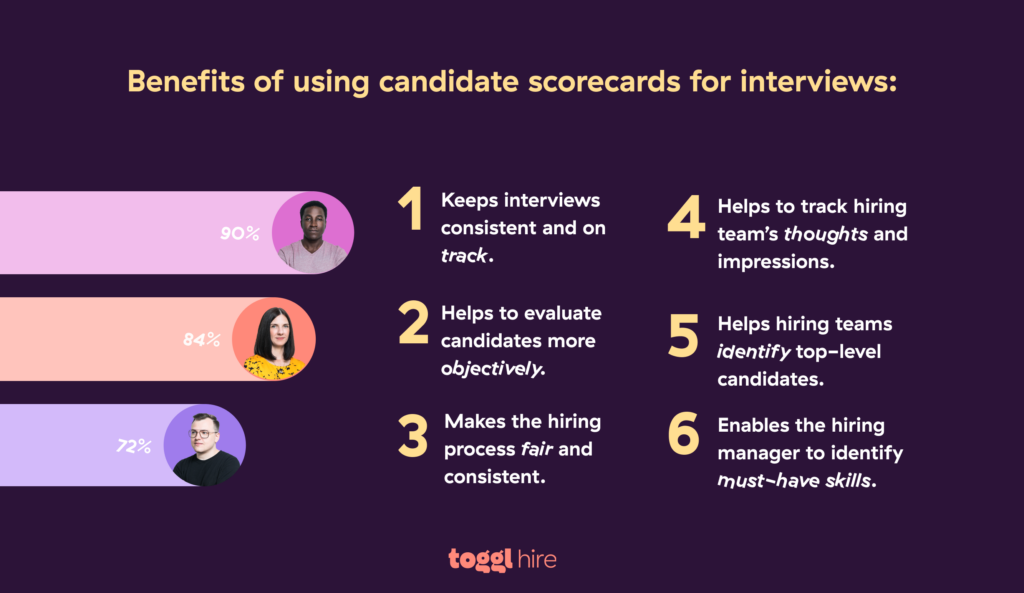
- More data to compare prospective candidates, especially when combined with other data on candidates, such as insights from pre-employment skills tests
- Easier to identify top talent as all applicants are compared by the same criteria
- Avoid unconscious bias by collaborating with other interviewers and sticking to an agreed-upon scoring method
- Together with job task analyses, interview scorecards can reduce any unrealistic job expectations that cause open positions to remain unfilled for a long time
- Deliver standardized, fair interviews across all candidates by sticking to scorecard details
- Remember candidates more clearly with specific notes on their skills and abilities
Potential disadvantages or minefields to avoid
Interviewers shouldn’t run into problems using an interview scorecard if they use their judgment. For instance, as HR practitioners have learned from doing so many more video meetings and interviews (than pre-Covid), eye contact is always important. So don’t just read the scorecard and take notes without making eye contact with the candidate.
Another myth is that scorecards make the interview rigid. They don’t have to. Because it’s ok to stray beyond the scorecard questions. So long as you’re gathering important information on a candidate and not wasting everybody’s time, keep doing what you’re doing!
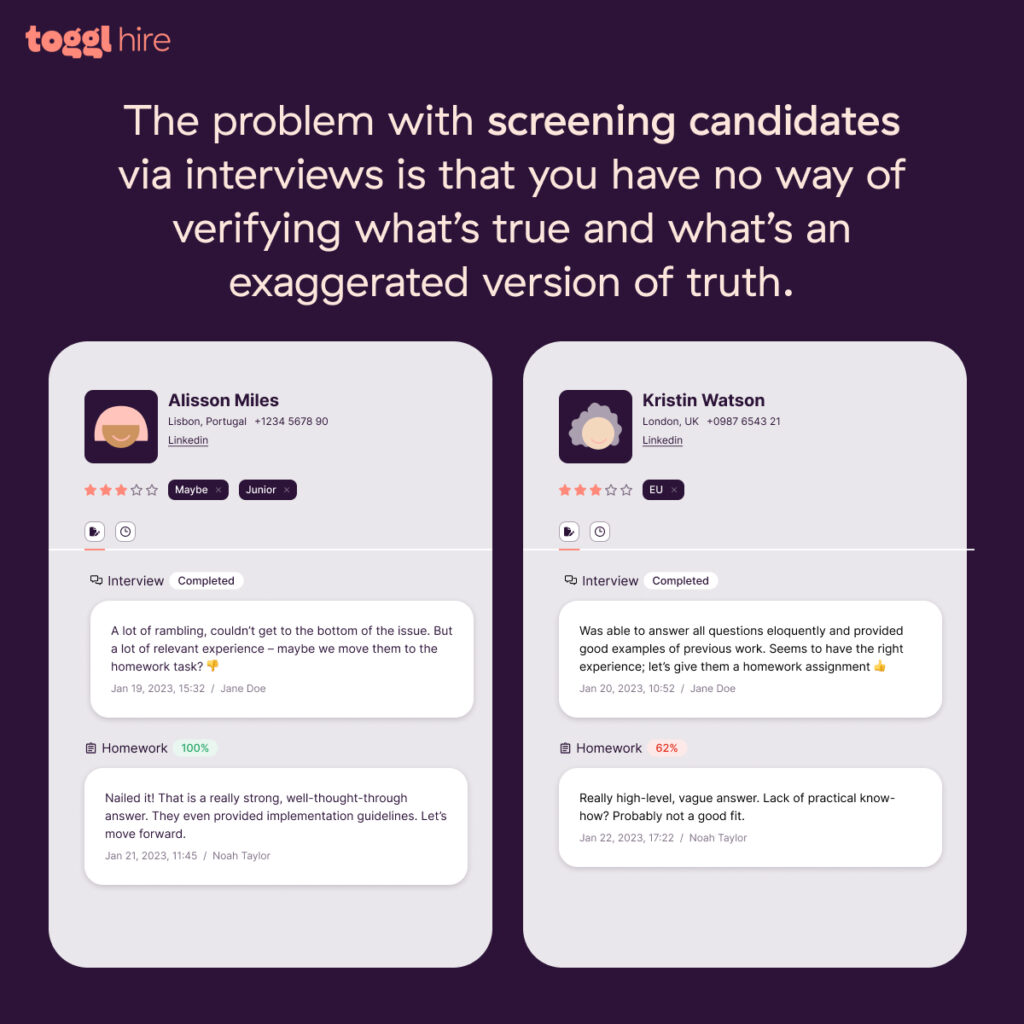
What’s more, it may get boring sticking to the same questions for a bunch of candidate interviews in a row. But remember, you’re gathering helpful intel, so don’t let the applicant think you’re bored. Since you’re gathering the same type of info for each candidate, you can analyze that data and make smarter, data-driven hiring decisions — and that’s cool!
How to design and use a candidate scorecard in the interview process
If you design a scorecard that’s easy to use and replicate for other roles, you’ll be helping your team deliver fast, fair interviews. Let’s explore how to get started.
#1 — Create a new scorecard in a spreadsheet or table
It’s a good idea to create a new interview scorecard for each job your team needs to fill, so it’s easier to manage, refer to quickly, and collaborate on with your colleagues.
Here’s how to create a basic scorecard template.
- Create four columns in your spreadsheet or table.
- Label the first column ‘Category of information’, the second column label will be ‘Candidate’s response’, the third column ‘Numerical rating’, and the fourth ‘Comments’
- Of course, you’ll also need to include basic data on the form, such as the candidate’s name, the date, and the job title
- And, that’s it for your basic template… Nooice! (or just use our free template)
Note on the numerical rating: You’ll be scoring each item, such as level of experience, on a scale of 1-5 (or 1-10 if you need a more detailed breakdown to differentiate candidates). Plus, you’ll also need to get everyone to agree on what each score represents. For instance, a score of 1 out of 5 is an answer that missed the mark altogether. These ratings will show the interviewer how well a candidate’s personality, qualifications, and experience suit the role specs.
Who’s involved at this stage? The hiring manager can create the framework for the interview scorecard template.
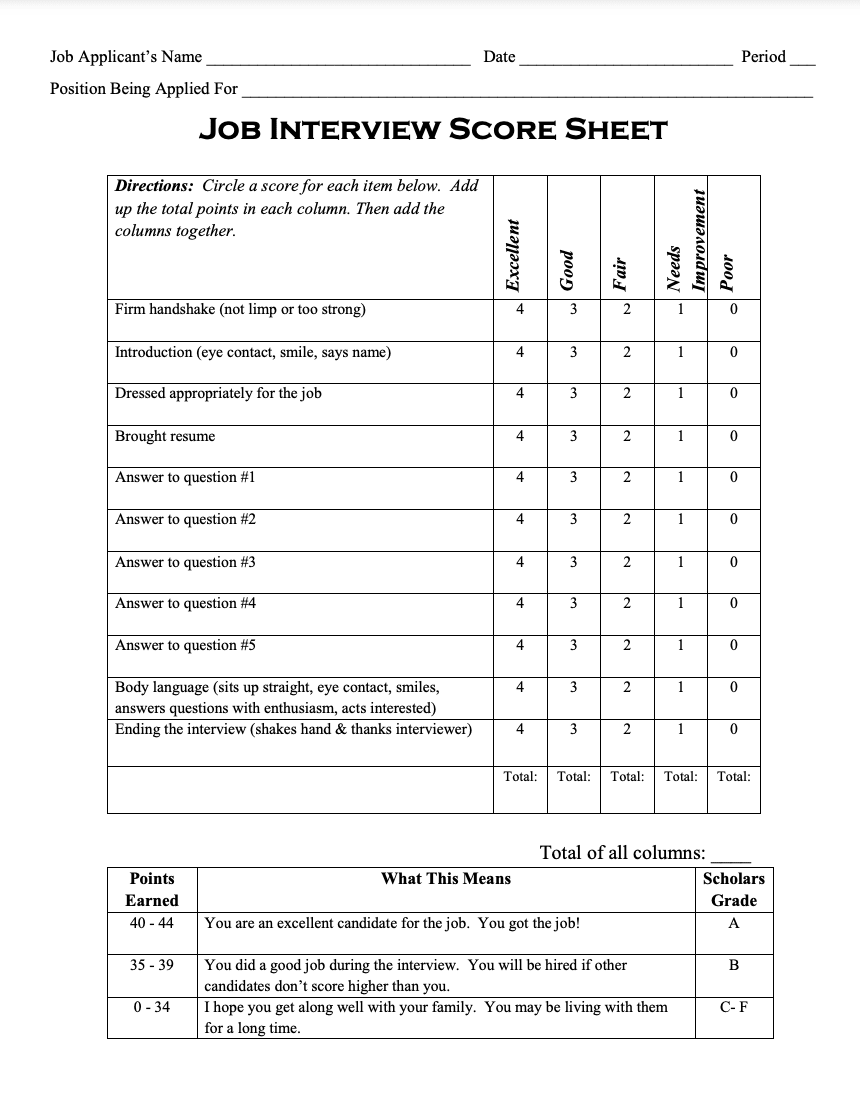
#2 — Decide what categories and rankings to include
Now that you have the basic template, it’s time to add some juicy filling into that pie crust — and populate your template with relevant categories.
The Harvard Business Review suggests including these broad criteria:
- Technical ability
- Leadership skills
- Interpersonal/collaboration skills
- Organizational skills
Who’s involved at this stage? The hiring manager and a person that oversees the specific role to input on the broader criteria.
#3 — Create interview questions that address all the hard and soft skills
With your categories chosen, you can now decide what specific question you need to ask to get a clear picture of the soft and hard skills of the potential new hire.
- Identify the skills:
You could use the data you gathered through performing job task analyses to help you identify or verify the essential skills for the position. Then, determine what hard, soft, and other role-specific skills are necessary.
✏️ Tip! For your soft skills questions, you could use behavioral interview questions — like “Tell me a time when…” — to ensure you get the data you need about their capabilities and encourage further discussion when needed.
- Design the questions:
Craft questions that will get candidates to share relevant information about their skills and experience using the data from your job task analysis and job descriptions.
For example, “Tell us about your greatest achievement as a social media manager?
Who’s involved at this stage? The hiring manager and the person overseeing the role break down the essential skills for success in the role.
What’s the difference between standard and management interview questions? Get the answer here:
#4 — Calculating the score
Once you’ve conducted the interview and each team member has filled out the scorecard, you’ll calculate each applicant’s total score.
Make sure you’re all in agreement about what each rating number means. For instance, 4 out 5 means they answered the question well and in a way that clearly demonstrated their experience or expertise.
Who’s involved at this stage? All interviewers. You’ll be collaborating to reach an agreement on who the top candidate is — based on the data and insight from your scorecards.
#5 — Shortlist candidates with Toggl Hire
The final step, and our favorite (of course) to ensure you’re making the right choice — is to perform skills tests to gain more quantitative data on their relevant skills and experience. That way, you boost the chances of selecting a quality candidate that’s a good fit for your company culture, and likely to succeed in the long run.
✏️ Tip! Incorporate skills assessments as a reliable, data-driven way to evaluate candidates‘ qualifications and skills before making an offer.
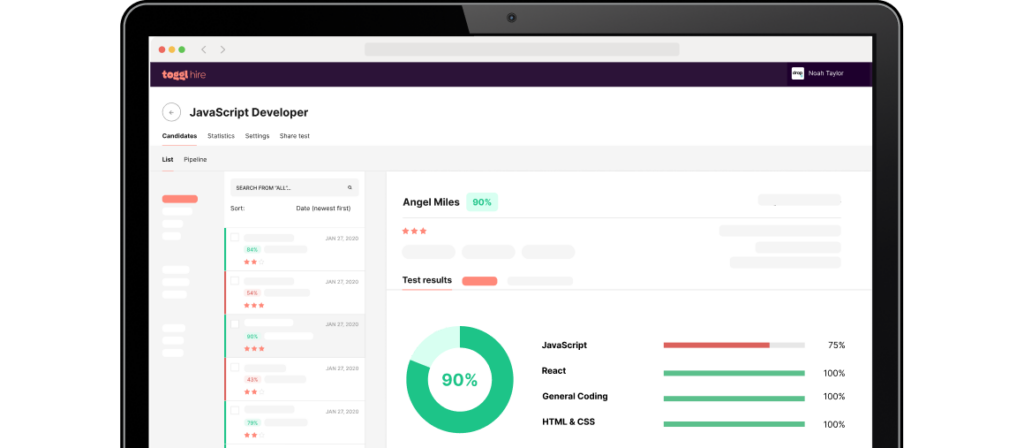
Bonus: Another template for interview scorecards
And finally, here’s another free template you can work from, especially if you’re performing interviews for technical roles, like a coder or role where your key criteria are very particular.
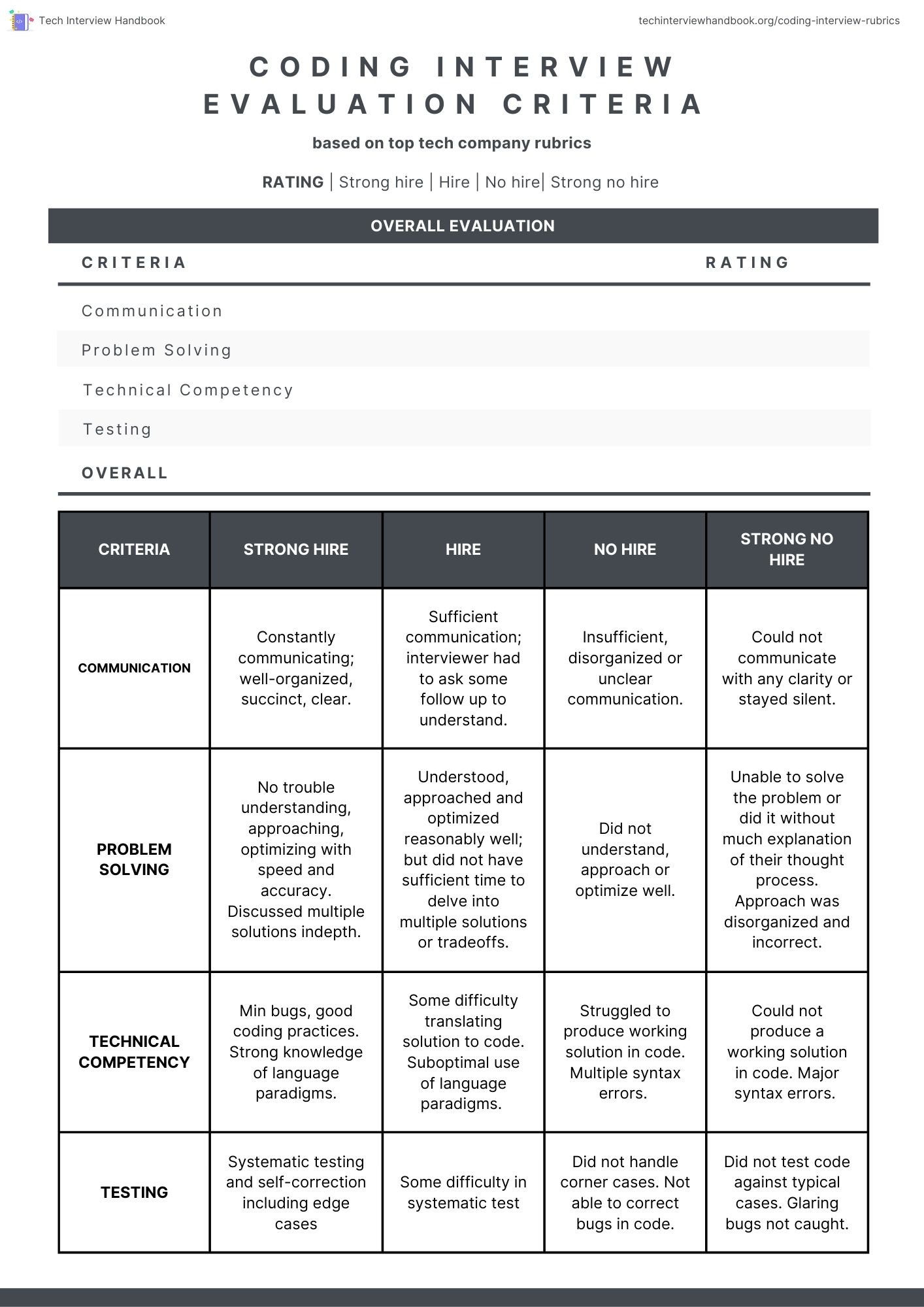
The wrap-up
Interview scorecards are a super helpful tool to include in your screening process. They give you solid data to use when selecting candidates, helping your team work smarter (and hopefully argue less! 😉 ).
Juste loves investigating through writing. A copywriter by trade, she spent the last ten years in startups, telling stories and building marketing teams. She works at Toggl Hire and writes about how businesses can recruit really great people.






